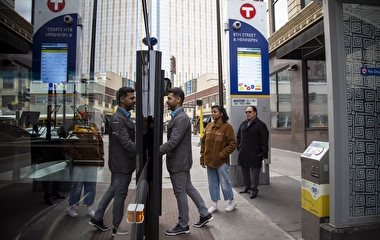
When the coronavirus pandemic is brought under control, will people return to stores in pre-COVID numbers? Will telecommuters head back to the office, by car or by bus? The answer to these questions, and many others, will have a major impact on transportation and society.
As its members began to consider budgets and policies for the upcoming biennium and beyond, the Minnesota House Transportation Finance and Policy Committee held two informational hearings in January on the future of transportation in a post-pandemic world. Rep. Frank Hornstein, committee chair, acknowledged there is a need to adapt to whatever “new normal” emerges, along with the challenges this new normal creates.
At Hornstein’s request, CTS organized presentations by experts from the University of Minnesota and by Giovanni Circella, director of the 3 Revolutions Future Mobility Program at the University of California, Davis.
Although travel by auto, public transit, air, and shared mobility all saw steep declines when the pandemic began, Circella said, car travel is rebounding much more quickly. Surveys of 15 US regions have also shown increased interest in car ownership among lower-income households and those without vehicles.
The technological upgrades many workers made at home to better telecommute may make that mode more prevalent as well. And Circella noted a “democratization” of shopping from home by a greater cross-section of society, adding that retail space will likely be modified forever. “The scientific research [indicates]…the longer the disruption, the more likely permanent effects will remain.”
COVID-19 also “atomized” traditional retail supply chains, said Karthik Natarajan, assistant professor of supply chain and operations in the U’s Carlson School of Management. The emphasis shifted from large shipments to stores to small deliveries at home, creating a need for quicker, shorter hauls. This points to a “transformative change” in transportation modes and parcel volumes over the next decade, he said, potentially putting more pressure on local transportation networks and substantially increasing carbon emissions.
Another impact: COVID-19 exacerbated transportation inequities. As white and more affluent workers rapidly abandoned buses and trains, “minority and low-wage essential workers kept riding,” said Professor Yingling Fan of the Humphrey School of Public Affairs. Advancing transportation equity, she said, entails creating multimodal transportation systems, ensuring quality transportation services accessible for all populations, and supporting fair decision-making processes that promote diversity and incorporate meaningful public engagement.
Professor Saif Benjaafar (Industrial & Systems Engineering) predicted that the “tele-economy” and other forces may make cities less important as hubs for products, services, and work. This could cause new patterns of travel and land use—and possibly an exodus of residents. “Over the next decade, this may call for a rethinking of government spending on transportation infrastructure, public transit, and transportation regulations,” said Benjaafar, who also directs the Initiative on the Sharing Economy.
Vehicle technology will also be transformative. Although US demand has stagnated for electric vehicles (EV), manufacturers are making significant investments, said Associate Professor Will Northrop, director of the T.E. Murphy Engine Research Laboratory. EV technology is advancing rapidly. “Batteries will have [far] fewer cold-weather issues in the next five years, accelerating consumer acceptance,” he said—and Minnesota could be a testing ground.
Connected and automated vehicles (CAVs) could first appear as micro-shuttles for passenger service or as pods-on-wheels for package deliveries, said Frank Douma, director of the State and Local Policy Program (SLPP) at the Humphrey School. “We should…get this technology out in front of the public so that they can understand it’s real and that it’s going to be viable in ways they might not otherwise expect,” he said.
Other presenters and their topics were McKnight Professor Shashi Shekhar (Computer Science and Engineering): the value and uses of spatial big data; Adeel Lari (director of innovative finance, Humphrey School): COVID impacts on telecommuting; and Lee Munnich (SLPP senior researcher): distance-based user fees and public-private partnerships.
All the presentations are available on the House archives site.
(Adapted from a House news post.)


